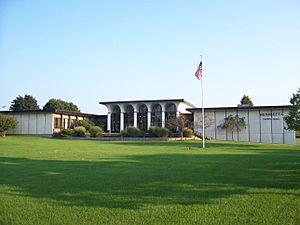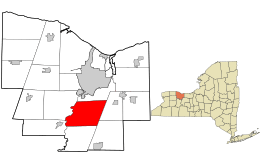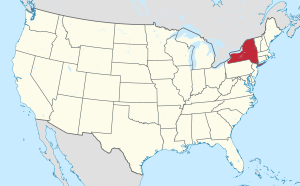Henrietta, New York facts for kids
Quick facts for kids
Henrietta
|
|
|---|---|

Town Hall
|
|

Location in Monroe County and the state of New York.
|
|

Location of New York in the United States
|
|
| Country | United States |
| State | New York |
| County | Monroe |
| Established | March 27, 1818 |
| Area | |
| • Total | 35.65 sq mi (92.32 km2) |
| • Land | 35.35 sq mi (91.56 km2) |
| • Water | 0.30 sq mi (0.77 km2) |
| Elevation | 600 ft (200 m) |
| Population
(2020)
|
|
| • Total | 47,096 |
| • Density | 1,332.28/sq mi (514.37/km2) |
| Time zone | UTC-5 (EST) |
| • Summer (DST) | UTC-4 (EDT) |
| ZIP code |
14467, 14534 ,14586, 14623
|
| Area code(s) | 585 |
| FIPS code | 36-055-34099 |
Henrietta is a town in Monroe County, New York, United States and a suburb of Rochester. The population of Henrietta is 47,096, according to the 2020 United States Census. Henrietta is home to the Rochester Institute of Technology and to one of the largest retail shopping districts in Monroe County.
Contents
History
The first residents of the Henrietta area were Native Americans. Although no evidence of Native American villages has been found in Henrietta, numerous artifacts and skeletons have been unearthed by farmers and archeologists over the past 200 years.
With the end of the American Revolution, several resident Native American tribes that had sided with the British were forced to leave Upstate New York. As a result, land became available for European settlers in the Finger Lakes and Genesee Valley regions.
The town of Henrietta was named after Henrietta Laura Pulteney, Countess of Bath in Great Britain. Her father Sir William Pulteney, 5th Baronet, was a major British investor from the Pulteney Association who owned the land that became the town. Henrietta Pulteney never visited the town named after her. Pulteney eventually sold his holdings, which then passed through the hands of several American investors.
The first European settlers were Major Ezekiel Scott and his wife Catherine, who purchased 900 acres in 1790. Most of the original arriving settlers were English.
Two villages, East and West Henrietta, arose in the area, both part of the Town of Pittsford. In 1818, a dispute about the recording of deeds prompted residents of the two villages to secede from Pittsford and form the town of Henrietta.
With the opening of the Erie Canal in 1825, Henrietta farmers gained access to the New York City market for their crops and the town prospered. In 1826, residents opened the Monroe Academy, the first incorporated school in Monroe County.
With the end of World War II. the population of Henrietta went from 3,000 to approximately 14,000 in ten years as people started moving to the Rochester suburbs. The building of the New York Thruway through Henrietta in the early 1950s made the town more desirable for commercial development. In 1968, the Rochester Institute of Technology moved from the city to a new campus in Henrietta. That same year, the National Technical Institute for the Deaf opened in Henrietta.
In the 1980s, with the completion of Interstate 390 and the building of Marketplace Mall, Henrietta developed into one of the major retail shopping destinations in Monroe County.
The Andrew Short House, Antoinette Louisa Brown Blackwell Childhood Home, and Tinker Cobblestone Farmstead are listed on the National Register of Historic Places in 1983.
Geography
The western town line of Henrietta is defined by the Genesee River. On the west side of the river are the towns of Chili and Wheatland. To the north of Henrietta is the town of Brighton, to the east are the towns of Pittsford and Mendon, New York, and to the south is the town of Rush. Henrietta is south of the City of Rochester, but does not share a border with the city.
According to the United States Census Bureau, the town has a total area of 35.6 square miles (92 km2), of which, 35.4 square miles (92 km2) of it is land and 0.2 square miles (0.52 km2) of it (0.53%) is water.
Both the New York Thruway (Interstate 90) and Interstate 390 run through Henrietta. A short section of the Erie Canal passes through the northeastern side of the town.
Demographics
| Historical population | |||
|---|---|---|---|
| Census | Pop. | %± | |
| 1820 | 2,181 | — | |
| 1830 | 2,310 | 5.9% | |
| 1840 | 2,085 | −9.7% | |
| 1850 | 2,513 | 20.5% | |
| 1860 | 2,249 | −10.5% | |
| 1870 | 2,280 | 1.4% | |
| 1880 | 2,243 | −1.6% | |
| 1890 | 2,135 | −4.8% | |
| 1900 | 2,062 | −3.4% | |
| 1910 | 1,972 | −4.4% | |
| 1920 | 1,794 | −9.0% | |
| 1930 | 2,142 | 19.4% | |
| 1940 | 2,728 | 27.4% | |
| 1950 | 3,385 | 24.1% | |
| 1960 | 11,598 | 242.6% | |
| 1970 | 33,017 | 184.7% | |
| 1980 | 36,134 | 9.4% | |
| 1990 | 36,376 | 0.7% | |
| 2000 | 39,028 | 7.3% | |
| 2010 | 42,581 | 9.1% | |
| 2020 | 47,096 | 10.6% | |
| U.S. Decennial Census | |||
As of the census of 2000, there were 39,028 people, 12,823 households, and 8,501 families residing in the town. The population density was 1,102.2 people per square mile (425.6/km2). There were 13,243 housing units at an average density of 374.0 per square mile (144.4/km2). The racial makeup of the town was 84.3% White, 6.9% African American, 0.27% Native American, 5.5% Asian, 0.03% Pacific Islander, 0.97% from other races, and 17.3% from two or more races. Hispanic or Latino of any race were 3.03% of the population.
There were 12,823 households, out of which 30.6% had children under the age of 18 living with them, 53.8% were married couples living together, 9.2% had a female householder with no husband present, and 33.7% were non-families. 22.7% of all households were made up of individuals, and 6.9% had someone living alone who was 65 years of age or older. The average household size was 2.60 and the average family size was 3.09.
In the town, the population was spread out, with 20.4% under the age of 18, 23.9% from 18 to 24, 26.8% from 25 to 44, 19.6% from 45 to 64, and 9.3% who were 65 years of age or older. The median age was 30 years. For every 100 females, there were 111.7 males. For every 100 females age 18 and over, there were 113.3 males.
The median income for a household in the town was $51,081, and the median income for a family was $60,803. Males had a median income of $39,636 versus $30,271 for females. The per capita income for the town was $19,821. About 3.2% of families and 9.1% of the population were below the poverty line, including 6.3% of those under age 18 and 3.3% of those age 65 or over.
As of the 2005-2009 American Community Survey, the racial makeup of the town was 81.5% White, 7.9% African American, 0.27% Native American, 5.9% Asian, and 3.1% Hispanic or Latino and 1.4% other.
Communities and locations in Henrietta
The East Henrietta hamlet is located at the crossroads of East Henrietta (US Route 15A) and Lehigh Station Roads (County Route 253). It was the site of the Monroe Academy, the first secondary school in the county, which later became Rush-Henrietta Senior High School. Also located at this intersection was the Kirby House, a nationally recognized example of Greek Revival architecture. It has since been relocated to a residential neighborhood near Stone Road in Henrietta.
The West Henrietta hamlet is located at the crossroads of West Henrietta (Route 15) and Erie Station Roads. It is the site of the West Henrietta Baptist Church, built in 1838. The West Henrietta Post Office and the West Henrietta Fire Department building is next to the church. The building in which the Post Office and Fire Department are located was an old school house that dates back to the 1920s. The building has seen various renovations from school house to fire station. A pizza restaurant is located in a general store building that dates back to 1906. The Cartwright Inn building was built in 1831 and housed a restaurant for many decades and now is closed.
Riverton was established in 1973 by the federal government as a planned community. The privately owned Riverton Golf Course is enjoyed by area golfers.
Sports and recreation
- Altitude Trampoline Park
- Bowl-a-Roll Lanes
- Erie Canal and trail - boating, biking, and walking
- Hansen Nature Center - nature exhibits and lectures
- Lehigh Valley Trail - a walking and biking trail along a former railroad bed
- Locust Hill Country Club - a private golf course in Henrietta and Pittsford
- The Pieters Family Life Center - swimming pool, gym equipment, and rehabilitative services
- Riverton Golf Club - a private golf course.
- Rochester Sports Garden - indoor sporting activities such as basketball, table tennis, and indoor soccer
- Tinker Nature Park - snowshoeing, cross-country skiing, biking, and walking on meadow and woodland trails.
Parks
- Andrews Park
- Belmanor Park
- Breese Park
- Hoskins Park
- Kenwick Park
- Lookup Park
- Martin Road Park
- Riverton Parks
- Tinker Nature Park
- Veterans Memorial Park
Education
Universities
Schools
- Bryant & Stratton College
- Rush-Henrietta Central School District
- School of the Holy Childhood - a non-profit agency for people with developmental disabilities.
- The Norman Howard School - a day school for children with disabilities.
- Continental School of Beauty
- Aab Cardiovascular Research Institute (University of Rochester)
Notable people
- Antoinette Brown Blackwell, first ordained female minister in the United States
- Shenise Johnson, professional WNBA basketball player
See also
 In Spanish: Henrietta (Nueva York) para niños
In Spanish: Henrietta (Nueva York) para niños

